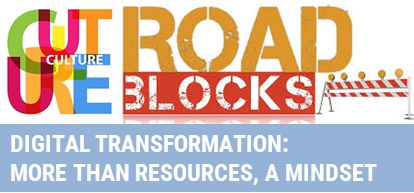When it comes to digital transformation of organisations, employees and the leadership are on different tangents.
It’s well established by now that digital transformation is the need of the hour as consumers have gone digital and organisations need to catch up soon. So, what’s slowing down this entire process of transformation in organisations?
Surprisingly, a study reveals that it’s the very culture that’s acting as a roadblock and the leadership team is to be blamed for this. The leadership neglects, underestimates or misunderstands the importance of culture in their digital transformation planning.
The study conducted by Capgemini, where 1700 professionals including senior business executives, managers and employees from 340 organisations across eight countries and five sectors were interviewed, reveals that organisational culture acts as a hurdle in digital transformation – 62 per cent of respondents from advanced economies feel so. Cultural issues continue to block digital transformation and it’s a problem that’s worsening. The existing culture and regular way of doing things is so deeply ingrained that it refuses to change.

Digital illiteracy among leadership leads to a disconnect and that hampers the transformation. Even if the change happens, it becomes ineffective as employees are not empowered to take on new challenges, not compensated for learning new expertise, and not incentivized to break new ground and build new models.
It is understood that employees will tend to resist any change because they still see the old behaviours as critical to their success and central to who they are, perceiving new norms as risky. However, what’s surprising is the leadership being averse to this change, and their failure to communicate a digital vision that is concrete enough for employees to internalise.
Respondents of this study point out that it’s the leadership that neglects, underestimates or misunderstands the importance of culture in digital transformation planning. Without laying a strong foundation for culture and aligning employees to a digital vision, it will be extremely difficult to make any meaningful progress towards digital transformation.
Employees are being side lined and disenfranchised in the culture change journey, and the gap between leadership and employee perceptions is stark. This explains why there is a significant perception gap between employees and leadership – the two important stakeholders of this change. The fact is that employees do not share their top executives’ enthusiasm for the organisations’ digital proficiency.
 Apparently, the leadership team either likes to stay in denial or has failed to communicate a clear vision to the employees. The very status of digital transformation in their respective organisations is the biggest point of contention between the leadership and the employees. Leaders believe they have a digital vision, employees disagree. Globally, 40 per cent of senior executives said they believed their organisation has a digital culture, while only 27 per cent of the employees felt the same way.
Apparently, the leadership team either likes to stay in denial or has failed to communicate a clear vision to the employees. The very status of digital transformation in their respective organisations is the biggest point of contention between the leadership and the employees. Leaders believe they have a digital vision, employees disagree. Globally, 40 per cent of senior executives said they believed their organisation has a digital culture, while only 27 per cent of the employees felt the same way.
Let’s take another case for instance – the study revealed that 85 per cent of the leadership like to believe that there is easy collaboration between different functions and business units of organisations. Interestingly, among employees, only 41 per cent agreed to that. Evidently, traditional hierarchical norms and operational silos are still very much a reality in most organisations.
Similarly, 75 per cent of the leadership said they believed that in their organisations, there prevails a culture of innovation, experimentation and risk-taking. Not surprisingly, only 37 per cent of the employees agreed to this.
Creating a digital culture is a mammoth task. It’s a multi-year endeavour that requires patience, tenacity and constant vigilance.
To put things into perspective, corporate culture can be simply defined by how a company works and operates whereas a digital culture is based on several parameters such as customer centricity, innovation, data-driven decision-making, collaboration, open culture, digital first mindset and flexibility.
A true digital culture leader will perform consistently well across the seven dimensions of digital culture and their leadership will largely succeed in aligning the wider organisation to the desired culture.



